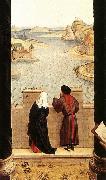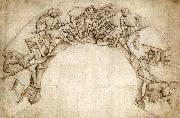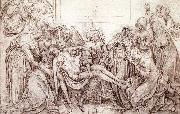WEYDEN, Rogier van der El petróleo que Pinta la ReproducciónAll WEYDEN, Rogier van der Oil PaintingsNetherlandish Northern Renaissance Painter, ca.1400-1464 |
|||

|
|||
|
|
|||
|
||||||||
| WEYDEN, Rogier van der Netherlandish Northern Renaissance Painter, ca.1400-1464 |
|
|||||||
|
|
||||||||
| Pintura identificación:: 63874 St Luke Drawing the Portrait of the Madonna 1450 Oil on oak panel Alte Pinakothek, Munich Through the opening supported by two columns, the main scene opens out onto a landscape in the background.Artist:WEYDEN, Rogier van der Title: St Luke Drawing the Portrait of the Madonna Painted in 1401-1450 , Flemish - - painting : religious |
||||||||
|
|
||||||||
| Pintura identificación:: 63875 Scupstoel 1447-50 Pen over chalk tracing on paper, 298 x 425 mm Metropolitan Museum of Art, New York The curious drawing of the Scupstoel is connected not with a painting but with a sculpture, more precisely the relief ornamentation of a capital. This capital belonged the pillars on the lower floor of the west wing of the Brussels town hall, built from around 1447 to 1450, and although severely damaged it is still extant. Exactly reflecting the motif of the drawing, a carving of men shoveling chairs (a literal translation of the word "Scupstoel" = shovel chair) runs in high relief around the entire capital. The drawing represents a development of the curved surface of the conical architectural member. It cannot have been actually copied from the relief, for a draftsman wishing to record the different aspects of the capital would have either drawn the figures individually or shown the whole scene as a flat strip. The drawing must thus have been connected with the design of the capital, with its special manner of surface projection corresponding to the requirements of the sculptors carving the relief. However, the drawing, which is relatively well preserved in spite of its large dimensions, cannot have been the actual model, which would have been worn out with intensive use. It seems very likely that the Brussels city council turned to their painter Rogier with a commission to design the capital. He must have prepared the basic design of the scene, and both the model followed by the sculptors and the extant drawing were presumably then copied from that design. Their author would have been an assistant in Rogier's workshop, perhaps one of the painters who participated in work on the panels of scenes from the life of St. Hubert (National Gallery, London), in which the faces of certain figures in the background are strongly reminiscent of the heads of the shoveling men. Perhaps Rogier himself merely sketched out the design and then directed his assistants to prepare a more detailed drawing as a model for the city council who had commissioned it. Or perhaps his design passed into the hands of the council, and he had a copy made by his assistants for the workshop stocks.Artist:WEYDEN, Rogier van der Title: Scupstoel Painted in 1401-1450 , Flemish - - graphics : other |
||||||||
|
|
||||||||
| Pintura identificación:: 63876 Visitation 1445 Oil on oak panel, 57 x 36 cm Museum der Bildenden K?nste, Leipzig This small Visitation, probably intended as a single panel, is related to the Miraflores Altarpiece, not in subject but in style. Comparatively speaking, it is a narrative picture, showing a definite event in its appropriate surroundings. Shortly after the Annunciation, Mary visits her cousin Elisabeth, who despite her advanced age has miraculously become pregnant, and has been carrying the future John the Baptist for six months. The picture illustrates the circumstances of the meeting described in St. Luke's Gospel much more clearly than many other earlier depictions. For example, the landscape divided up by paths behind the Virgin Mary, from which she seems to be approaching small figures of people riding and walking indicate that it is passable - show that she has traveled a long way to visit her cousin. Elisabeth lives in hilly country, represented by the hill with the complex of fortress-like buildings outside which her husband Zacharias is playing with a dog. The open courtyard gateway, and even more so the path dynamically winding downward, show that the pregnant older woman has hurried respectfully to meet the young girl as Mary takes the last few steps. Each of them acknowledges the miracle of pregnancy and is laying a hand on the other's belly, while Elisabeth's outstretched arm and pale hand, shown against Mary's dark blue dress, leave us in no doubt which is the more important child. The gestures, at once tender and eloquent, are typical of Rogier's expressive style. The picture is also closely related to the version of the same subject on the right wing of the Annunciation Triptych (Galleria Sabauda, Turin) which is of the same width but considerably taller and thus makes a much narrower composition. The smaller version therefore appears less dramatic by comparison; Elisabeth's house does not tower over her so much. It is possible that an older design by Rogier was the model for both painting. These hands and facial types, the figures, and such features as the modeling of the forms resemble those of the Miraflores Altarpiece. Dendrochronology provides a useful lead to the date of the Visitation, for the wooden panel used comes from the same piece of timber as a part of the panels of the picture known as the Abegg Triptych (Riggisberg near Berne), which was painted in Rogier's workshop and can be dated to around 1445.Artist:WEYDEN, Rogier van der Title: Visitation Painted in 1401-1450 , Flemish - - painting : religious |
||||||||
|
|
||||||||
| Pintura identificación:: 63878 Portrait of a Man 1450 Oil on panel, 75 x 50 cm Koninklijk Museum voor Schone Kunsten, Antwerp This portrait is probably a copy from c. 1500 of an original by Rogier van der Weyden which, judging by the fashion of the clothes, was executed around or shortly after the middle of the century. An unusual feature is the elegant low neck, which makes the face seem small. Possibly this, like the clock, and the inscriptions reminding the viewer of the transience of life, was a deviation from the original.Artist:WEYDEN, Rogier van der Title: Portrait of a Man Painted in 1401-1450 , Flemish - - painting : portrait |
||||||||
|
|
||||||||
| Pintura identificación:: 63879 Descent from the Cross 1460 Pen over chalk drawing on paper, 240 x 357 mm Mus?e du Louvre, Paris Paintings in the style of Rogier van der Weyden that are no longer extant are also recorded in several drawings not from the workshop of the Brussels town painter. Among the most notable is this Descent from the Cross, frequently said to derive from an original by Rogier himself, and sometimes even ascribed to Robert Campin. Surrounded by Christ's mourning friends, Joseph of Arimathea and Nicodemus are carrying the body just taken down from the Cross to the tomb. The very unusual outer area, with raised sections at the sides where angels hover with the nails and the crown of thorns, may refer to the place where the painting connected with this drawing was installed - perhaps it was to be placed below a tall window. The composition obviously appealed to contemporary taste, and was copied in painting and sculpture several times. It shares important elements with Rogier's most influential work, the Deposition (Prado, Madrid): there are considerable similarities in the construction of the scene, which again is transferred to an altar shrine, and in some of the figures, particularly those of the bearded Joseph of Arimathea and Mary Magdalene. The Virgin Mary and the flying angels, on the other hand, are more like the corresponding figures in the Crucifixion Triptych (Kunsthistorisches Museum, Vienna), and the figure of St John resembles his counterpart in the Seven Sacraments Altarpiece (Museum of Fine Arts, Antwerp). However, while in a work like the St Columba Altarpiece (Alte Pinakothek, Munich) the figures, taken from various different pre-existing models, are merged into a meaningful whole, there are discrepancies in the Descent from the Cross. Joseph of Arimathea seems to be standing still as he holds the corpse, but the legs of Nicodemus suggest that he is walking away, an action that clashes with the Virgin's heartfelt embrace of Christ. And the Magdalene is obviously shown twice, as the woman with the vessel of ointment - the saint's attribute - standing on the extreme right, veiled as in the Crucifixion Triptych, and as the figure of the Magdalene from the Deposition, identifiable as the former sinner by her low-cut, expensive dress. These inconsistencies cannot be reconciled with Rogier's careful, confident style, and the drawing cannot therefore be considered a copy from a work conceived by him. In fact it is not yet clear whether it is a copy at all, or whether it may be a sketch for a design.Artist:WEYDEN, Rogier van der Title: Descent from the Cross Painted in 1401-1450 , Flemish - - graphics : study |
||||||||
|
|
||||||||
| ARTISTA PREVIO PROXIMO ARTISTA | ||||||||
|
|
||||||||
|
WEYDEN, Rogier van der Netherlandish Northern Renaissance Painter, ca.1400-1464 |
||||||||
|
|
||||||||
|
CONTACTE EEUU |










